List of listed objects in Globasnitz
The list of listed objects in Globasnitz contains the 16 listed , immovable objects of the municipality Globasnitz .
Monuments
| photo | monument | Location | description | Metadata |
|---|---|---|---|---|

|
Architectural parts of an ancient temple ObjectID : 128889 |
Globasnitz location KG: Globasnitz |
On the square in front of the former post office there are three columns of a Roman temple in Tuscan order (C 160.280). |
ObjektID : 128889 Status : Notification Status of the BDA list: 2020-02-29 Name: Architectural parts of an ancient temple GstNr .: 239 Roman columns Globasnitz |

|
Light column at the cemetery ObjectID : 80957 |
Globasnitz location KG: Globasnitz |
The light column from the early 16th century is a tabernacle on an octagonal pillar with the coat of arms of the Weispriacher in the form before 1444. |
ObjectID : 80957 Status: § 2a Status of the BDA list: 2020-02-29 Name: Lichtsäule am Friedhof GstNr .: 183 Lichtsäule Globasnitz |

|
Wayside shrine, parish cross ObjectID : 80969 |
Globasnitz location KG: Globasnitz |
In 2004 the wayside shrine was restored with the help of federal funds. Note: data error. correct lot number: 179/4 |
ObjectID : 80969 Status: § 2a Status of the BDA list: 2020-02-29 Name: Bildstock, Pfarrkreuz GstNr .: 179/1 |

|
Corridor chapel Petschnig-Kreuz / Petschnig-Kriz ObjektID : 71561 |
Globasnitz location KG: Globasnitz |
ObjectID : 71561 Status : Notification Status of the BDA list: 2020-02-29 Name : Flurkapelle Petschnig-Kreuz / Petschnig-Kriz GstNr .: 744 Petschnig-Kreuz, Globasnitz |
|
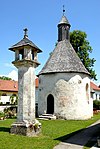
|
Karner ObjectID : 80961 |
Globasnitz 10 KG location : Globasnitz |
The Karner is a late Romanesque rotunda with a horseshoe-shaped apse, a pointed portal and a cross-rib vaulted interior with paintings. |
ObjectID : 80961 Status: § 2a Status of the BDA list: 2020-02-29 Name: Karner GstNr .: .3 / 2 Karner Globasnitz |
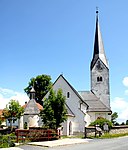
|
Catholic parish church Mariae Himmelfahrt and cemetery with chapel integrated into the wall ObjectID : 61772 |
Globasnitz 10 KG location : Globasnitz |
The church is essentially a Romanesque building, which was Gothic modified and extended in 1946. The nave has a late Gothic loop rib vault, the choir is vaulted with cross ribs. The high altar with sacrificial portals from 1770 is remarkable. |
ObjektID : 61772 Status: § 2a Status of the BDA list: 2020-02-29 Name: Catholic parish church Mariae Himmelfahrt and cemetery with chapel integrated into the wall GstNr .: .3 / 1; 183; .3 / 2 Parish Church Globasnitz |
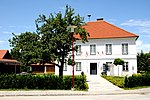
|
Iuenna Museum / former Elementary school ObjectID : 61768 |
Globasnitz 13 KG location : Globasnitz |
In the former elementary school there is a museum of antiquities, opened in 1982, with excavations from 1978 to 1981 and 1991 (Hemmaberg). Documentation and exhibits (mosaics from the memorial church and burial chapel), small finds from late antique graves from the 5th and 6th centuries AD. |
ObjectID : 61768 Status: § 2a Status of the BDA list: 2020-02-29 Name: Iuenna-Museum / former. Elementary school GstNr .: 237 Iuenna Museum, Globasnitz |

|
Pfarrhof und Pfarrstadel ObjectID : 61769 |
Globasnitz 58 KG location : Globasnitz |
Two-storey building from the 17th century, remodeled in the 18th century; Stucco ceilings, remarkable tiled stoves on the first floor. 1995 exterior restoration. Late Gothic winged altar from the church on Simonberg in safekeeping. In the vicarage outbuilding, walled in is a relief from a Roman tomb with the representation of erotes originally carrying two garlands (CSIR II 4, 357). |
ObjectID : 61769 Status: § 2a Status of the BDA list: 2020-02-29 Name: Pfarrhof und Pfarrstadel GstNr .: .2 / 1 Pfarrhof Globasnitz |
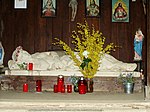
|
Spring sanctuary, Rosaliengrotto with fountain bowl on Hemmaberg ObjectID : 81056 |
Slovenjach location KG: Globasnitz |
In the second half of the 17th century, a chapel was built near the spring in a cave, which was already used in antiquity. The marble fountain bowl by the source is a former Romanesque font. |
ObjektID : 81056 Status : Notification Status of the BDA list: 2020-02-29 Name : Spring sanctuary, Rosaliengrotte with fountain bowl at Hemmaberg GstNr .: 729 Rosalia grotto at Hemmaberg |

|
Catholic branch church hl. Simon am Simonberg ObjectID : 62946 |
Slovenjach 13 Location KG: Globasnitz |
The small Gothic church from the beginning of the 17th century, with a porch and roof turret, contains three altars from the middle of the 17th century. |
ObjectID : 62946 Status: § 2a Status of the BDA list: 2020-02-29 Name: Kath. Filialkirche hl. Simon am Simonberg GstNr .: .105 Filialkirche hl. Simon, Globasnitz |

|
Catholic branch church hll. Hemma and Dorothea am Hemmaberg ObjectID : 63226 |
Slovenjach 5 Location KG: Globasnitz |
A late Gothic church built around 1500 was expanded in a baroque style at the end of the 17th century. The choir is painted uniformly from the beginning of the 17th century, the high altar and two side altars date from the same period. The Rosalienkapelle with altar was added to the north after the plague in 1680. |
ObjectID : 63226 Status: § 2a Status of the BDA list: 2020-02-29 Name: Kath. Filialkirche hll. Hemma and Dorothea am Hemmaberg GstNr .: .93 Filialkirche Hemmaberg |

|
unpaved settlement, late antique hilltop settlement Hemmaberg ObjectID : 130228 |
Hemmaberg (Gradnik) KG location : Globasnitz |
The settlement, which existed from around 400 to 600, comprised five churches and, among other things, three large stone-built pilgrim houses. |
ObjectID : 130228 Status : Notification Status of the BDA list: 2020-02-29 Name: unpaved settlement, Hemmaberg hillside settlement from late antiquity, GstNr .: 692; 717; 726/1; 728; 729; 733; 1281; 1283; 1284 Hemmaberg |
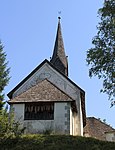
|
Catholic branch church hl. John the Baptist ObjectID : 61990 |
Jaunstein 11 KG location : Jaunstein |
The baroque church has a high turret, a brick porch and a sacristy annex to the south of the polygonal choir. On the high altar from 1690 there is an altar sheet Baptism of Christ , the side altars date from the middle of the 18th century. |
ObjectID : 61990 Status: § 2a Status of the BDA list: 2020-02-29 Name: Kath. Filialkirche hl. John the Baptist GstNr .: .10 Church Jaunstein |

|
Medieval burial ground, Ostrogothic burial ground ObjectID : 89573 |
Globasnitz location KG: St. Stefan |
In the area of Globasnitz was the Roman road station named on the Tabula Peutingeriana and the vicus Iuenna, on the main road Virunum ( Zollfeld ) - Celeia ( Celje ). Grave fields (including now Gothic graves), coin finds as well as building remains and relief architectural parts of monumental marble grave structures are known from this settlement, which are located in the local archaeological museum, including reliefs (CSIR II 5, 667 and CSIR II 4, 312). |
ObjectID : 89573 Status: § 2a Status of the BDA list: 2020-02-29 Name: Grave field of the Middle Ages, Ostrogothic grave field GstNr .: 2083 |
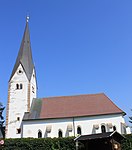
|
Catholic parish church Sankt Stefan (under Feuersberg) and cemetery ObjectID : 63225 |
Sankt Stefan 24 KG location : St. Stefan |
The late Gothic church with a Romanesque western tower is surrounded by a high defensive wall with loopholes. Some Roman epitaphs are built into the southern outer wall of the church. There are four baroque altars in the vaulted interior. |
ObjectID : 63225 Status: § 2a Status of the BDA list: 2020-02-29 Name: Catholic parish church Sankt Stefan (under Feuersberg) and cemetery GstNr .: .74; 575/2 Church of St Stefan in Jauntal |

|
Catholic branch church hl. Martin und Friedhof ObjektID : 63664 |
Wackendorf 24 KG location : Wakendorf |
The former fortified church is a late Gothic building from the 15th century with buttresses. After a tower collapse in 1970, a sacristy and a new tower were built north of the choir. On the nave you can see loopholes from an upper floor. The iron plate door of the west portal has a shooting hole. In the cross-rib vaulted choir there are remarkable remains of frescoes from the first half of the 15th century. The high altar from 1741 was originally in St. Michael ob Bleiburg. |
ObjectID : 63664 Status: § 2a Status of the BDA list: 2020-02-29 Name: Kath. Filialkirche hl. Martin and Friedhof GstNr .: .49; 485/2 Church of Wakendorf |
Web links
Commons : Listed objects in Globasnitz - collection of pictures, videos and audio files
Individual evidence
- ↑ a b Carinthia - immovable and archaeological monuments under monument protection. (PDF), ( CSV ). Federal Monuments Office , as of February 14, 2020.
- ↑ a b c d e f Dehio manual. The art monuments of Austria. Carinthia . Anton Schroll, Vienna 2001, ISBN 3-7031-0712-X , p. 198.
- ↑ a b Dehio manual. The art monuments of Austria. Carinthia . Anton Schroll, Vienna 2001, ISBN 3-7031-0712-X , p. 197.
- ^ Dehio manual. The art monuments of Austria. Carinthia . Anton Schroll, Vienna 2001, ISBN 3-7031-0712-X , p. 291.
- ^ Dehio manual. The art monuments of Austria. Carinthia . Anton Schroll, Vienna 2001, ISBN 3-7031-0712-X , p. 290f.
- ^ Dehio manual. The art monuments of Austria. Carinthia . Anton Schroll, Vienna 2001, ISBN 3-7031-0712-X , p. 288f.
- ^ Dehio manual. The art monuments of Austria. Carinthia . Anton Schroll, Vienna 2001, ISBN 3-7031-0712-X , p. 326.
- ^ Dehio manual. The art monuments of Austria. Carinthia . Anton Schroll, Vienna 2001, ISBN 3-7031-0712-X , p. 624.
- ^ Dehio manual. The art monuments of Austria. Carinthia . Anton Schroll, Vienna 2001, ISBN 3-7031-0712-X , p. 1043.
- ↑ § 2a Monument Protection Act in the legal information system of the Republic of Austria .